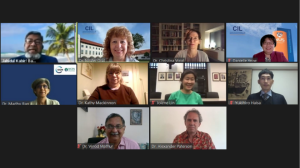Media - Gallery
- Media
- Looking Ahead To The CBD CoP15: Opportunities And Challenges Posed By Other Effective Area-Based Conservation Measures (OECMs)
Looking Ahead To The CBD CoP15: Opportunities And Challenges Posed By Other Effective Area-Based Conservation Measures (OECMs)
Looking Ahead to the CBD COP15: Opportunities and Challenges Posed by Other Effective Area-Based Conservation Measures (OECMs)
13 December 2021

(From top left: Md. Jahidul, Dr. Nilüfer Oral, Dr. Christina Voigt, Danielle Yeow
From middle left: Dr. Madhu Rao, Dr. Kathy Mackinnon, Dr. Jolene Lin, Yukihiro Haisa
From bottom left: Dr. Vinod Mathur, Dr. Alexander Paterson)
On 13 December 2021, the Asia-Pacific Centre for Environmental Law (APCEL) held a webinar on ‘Looking Ahead to the CBD COP15: Opportunities and Challenges Posed by Other Effective Area-Based Conservation Measures (OECMs)’. This was organised in collaboration with the IUCN World Commission on Protected Areas (WCPA), the IUCN World Commission on Environmental Law (WCEL) and the Centre for International Law (CIL).
This webinar featured a diverse panel of experts from various fields and jurisdictions. Dr. Madhu Rao (Chair, IUCN WCPA) and Dr. Christina Voigt (Chair, IUCN WCEL) began by introducing OECMs, explaining its definition and how OECMs are designed to complement protected areas; enable improved recognition and support for the effective and equitable management of areas; and the long-term in situ conservation of biodiversity. As it is expected that many parties to the Convention on Biological Diversity (CBD) will use OECMs in addition to protected areas to fulfill Target 3 of the Global Biodiversity Framework, there is a need to advance discussion about the legal and regulatory frameworks for OECMs.
Harry Jonas (WWF; IUCN WCPA) and Dr Kathy MacKinnon (Co-Chair, IUCN WCPA) examined Decision 14/8 of the Conference of the Parties to the CBD, which was adopted in 2018. They gave a brief yet comprehensive overview of the important scientific and technical advice for OECMs within Decision 14/8.
Experts from various jurisdictions then expanded the discussion with examples of how OECMs have been implemented in specific countries. They observed how laws and policies have increased the recognition of OECMs and can, in turn, help to address associated challenges such as measuring effectiveness across different ecosystems and within areas governed by different authorities. The following experts presented case studies on the OECMs in their respective jurisdictions:
- Yukihiro Haisa (Ministry of Environment): Japan
- Jadhidul (Forest Department) Bangladesh
- Vinod Mathur (Indian National Biodiversity Authority): India,
- Candic Stevens (WFA; The Sustainable Landscape Finance Coalition): South Africa
- Marcela Santamaría Gómez (Universidad de Los Andes) and Clara L. Matallana Tobón (Pontificia Universidad Javeriana-Colombia): Colombia
Finally, Dr Alexander Paterson (IUCN WCPA; University of Cape Town) discussed the legal and policy dimensions of OECMs; and Dr. Nilufer Oral (CIL) commented on how OECMs could be taken to the international level, especially in relation to the high seas.
To close the session, Dr. Jolene Lin (NUS APCEL) highlighted how this discussion is part of the synergies growing between OECMs and broader efforts to address environmental crises. In particular, she touched on the need for increasing attention and funding for biodiversity conservation, and for creating accountability structures to ensure that concrete action is taken by decisionmakers.
For more information, please refer to below :

